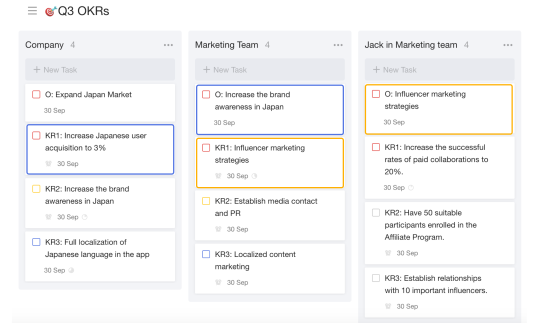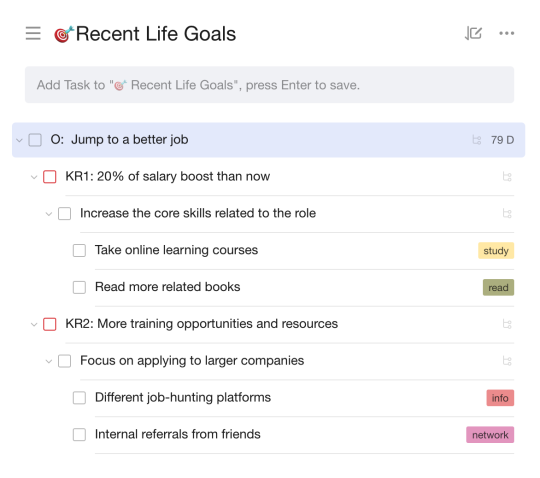
What is OKRs?
Drown in the jargon river where so many abbreviations represent different business management methods, the OKRs (Objectives and Key Results) framework stands out due to its popularity among some household names, e.g. Google and Linkedin. Moving through Andy Grove, who first introduced Management by Objectives to Intel in the 1970s to now John Doerr, whose book – Measure What Matters – probes greater depth of OKRs in the workplace. How to embed the company’s purpose and values into everyday goal-setting and outcomes throughout the company’s workforce, is where OKRs come into play.
The basic process of implementing the OKRs is: The company sets a goal (normally for the coming quarter), and lists some metrics that can be used to measure whether this goal is met. With the same practice, this process further goes to different teams and then down to individuals.
Here’s an OKRs example displayed under Kanban View at TickTick:

From the example above, we can clearly see Q3 OKRs are displayed and sub-divided in three levels: Company’s OKRs > Marketing Team’s OKRs > Jack’s OKRs in Marketing Team.
*Key Result 1 of the company is the Objective of Marketing team, and KR1 of Marketing team is Jack’s individual Objective. It is not necessary to always have correspondent O and KR, but the full path can go similarly like this to other teams and individuals.

OKRs vs. KPIs
To understand OKRs better, we may also have to identify where it differs from another performance evaluation method: KPIs (Key Performance Indicators).


Why do OKRs work?
Encourage company-wide focus
OKRs create the same context within a company, which connects and immerses everyone as a whole, by setting the company’s biggest objectives and identifying what matters most to achieve these objectives. A common sense will form organizationally: working towards the goals, trimming the unnecessary, and keeping anything off-track away from the runway. Motivated to only focus on what’s important, individuals are more likely to outperform. With all efforts channeled into one thing, there’s also higher possibility for the company to win the game.
Ensure top-down alignment
The traditional management method tends to be like: the top tier dictates, and the rest executes. One of the biggest issues caused by that is the disconnection between decision and execution, which may lead to employees’ lack of higher-level thinking, with only the hard-work on completing given tasks, not knowing what the meaning of their everyday work is. OKRs solve this problem because of its transparency and accountability. On the premise of knowing what the company steers towards, and what the team’s responsibility is, one can be well-aware of what their work should be built around. One is also less likely to feel themselves drifting away from others, especially when they are at the bottom level.
Enhance both-side engagement
When setting the company’s OKRs, the proven way is to involve not only leaders of the company, but also individuals, into the discussion and goal-setting. If well-implemented, OKRs also allow adjustment and continuous improvement. Both the leadership and individuals can check on the key results regularly, adjust, or even abandon the goals according to real-time circumstance changes. That way the voice of individuals has been heard and commitment from both sides has been greatly increased.

Tips of implementing OKRs
1. When there are too many focuses, there is no focus.
Some may fall into an OKRs pitfall – Achieve as many objectives as possible. When asked about what the company’s objectives are, the leadership themselves may even be confused, let alone other employees. Thus, setting only one objective of the top priority and then investing resources in it to do exceptional work, is perhaps better to enhance the sole concentration in everyone’s mind. Conversely, if there are too many focuses, people may find it hard to decide which they should really pay attention to.
2. Allow sufficient time to test out your OKRs.
Setting quarterly OKRs is what’s been used in most cases, even though some prefer the 2-month duration or a year. If you’re implementing OKRs for the first time, make sure the duration is not too long or too short, because you need time to test out the key results, and also need to adjust or reset the goals as OKRs progress.
3. Be careful of the goal-setting.
Make sure the objective you’ve set for the company/team/individual is ambitious and also inspiring, not to be unrealistic or too easy-to-reach. It might immediately scare people away if it seems too challenging. On the flip side, they may feel less-motivated if it seems quite attainable. A method mentioned by Christina Wodtke (author of Achieving Your Most Important Goals with Objectives and Key Results) is: Target the rate at 5 with full score 10, because that would be something challenging but still achievable, 7/10 can be considered as a success, and 10/10 is unsuitable to be KRs.
4. Communicate, communicate, and communicate.
Communication and engagement alongside the way is the key to successful implementation of OKRs. Ensure employees have been involved before the objective-setting, in the process of checking on key results and also reflecting on the results of OKRs implementation.

Personal OKRs
Walking through all the above, you might come to the recognition that OKRs could be effective for fast-growing companies. But some of you might also wonder what it’s to do with me if I’m not the founder of a company or the leader of a team. Like so, can OKRs only be used at work for companies? The answer is NO, because it’s a general methodology for goal setting and achieving, which can be used for personal life as well.
*Note: Personal OKR here doesn’t mean individual OKRs at work.
Christina Wodtke, the author of Achieving Your Most Important Goals with Objectives and Key Results, shared how OKRs modelled her life as a professional writer:
To say OKRs have changed my life would be an understatement. They have made my life possible. They are the backbone that holds my life together.
Here is a personal OKR example she’s given:
O: Model life as a professional author
KR1: Rough draft of Continuous Feedback to Alpha reader list (and Cathy) with actionable feedback
KR2: Working with Pictures V2 on Amazon with 4 five star reviews
KR3: Product-Market Fit book (Creative Founder) interviews complete with essays at 2K views each or higher
Similarly, if the most important goal currently in your life is the IELTS test for example, then your OKRs might be like:
O: Get the C1 level in IELTS exam
KR1: Enrol in courses to improve weak skills, e.g. Listening
KR2: Enhance strong skills e.g. Speaking by practicing more
KR3: Increase the overall score by 1 point
Or, if one of your recent life goals is to find a better job, then the personal OKRs could be:
O: Find a better job
KR1: 20% of salary boost
KR2: More training opportunities and resources
Tip: Further divide these key results into actionable tasks, with TickTick’s new task nesting feature! Then it will look like:

To wrap up, OKRs provide a general methodology of goal setting and reaching for startups/fast-growing organizations, and it can also be well applied into personal life. It helps steer us towards the most important goals in work/life and get closer and closer to what we’d wish ourselves to be.



